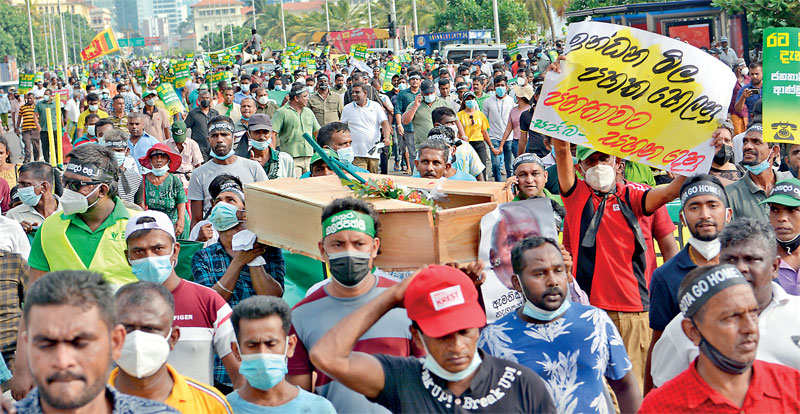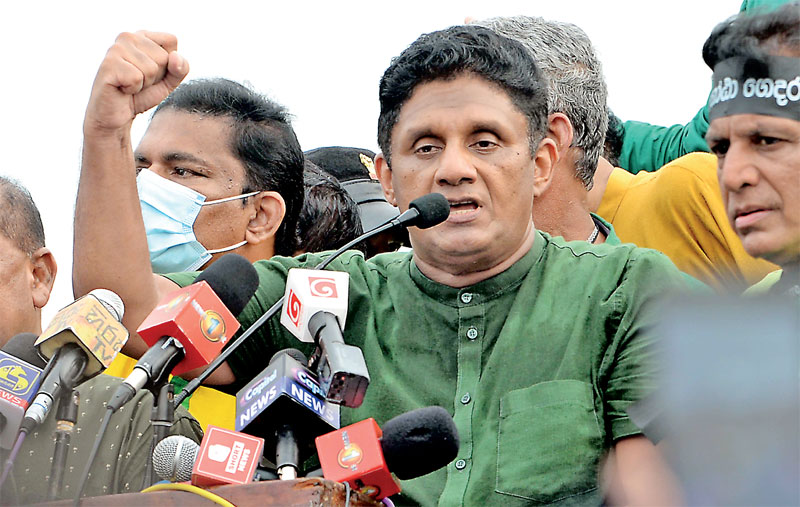Sunday Dec 14, 2025
Sunday Dec 14, 2025
Thursday, 17 March 2022 02:34 - - {{hitsCtrl.values.hits}}


SJB Leader Sajith Premadasa - Pix by Shehan Gunasekara
 March 15 feels like a tipping-point. The citizens addressed the President a day before the President addressed the citizens. The Samagi Jana Balavegaya (SJB) lived up to its name with the massive wave of popular protest that hit the seat of power, Colombo, getting in the face of the armed STF at the Presidential Secretariat, setting fire to a coffin with President Gotabaya Rajapaksa’s name on it. Belying (or notwithstanding) media speculation of internal dissonance, the SJB proved itself an impressive mass movement with a militant edge. There was no doubt that its target was Gotabaya Rajapaksa’s rule.
March 15 feels like a tipping-point. The citizens addressed the President a day before the President addressed the citizens. The Samagi Jana Balavegaya (SJB) lived up to its name with the massive wave of popular protest that hit the seat of power, Colombo, getting in the face of the armed STF at the Presidential Secretariat, setting fire to a coffin with President Gotabaya Rajapaksa’s name on it. Belying (or notwithstanding) media speculation of internal dissonance, the SJB proved itself an impressive mass movement with a militant edge. There was no doubt that its target was Gotabaya Rajapaksa’s rule.
On a makeshift platform, Sajith Premadasa was cheering the crowd, pumping his arms with a clenched fist salute. This sure ain’t Ranil Wickremesinghe’s UNP. This is a post-UNP populist party with a youthful new leader, capable of mass mobilisation and confrontation.
Premadasa pledged that the demonstration was the commencement of a national campaign to replace Rajapaksa rule, promising to build the Movement drilling-down past the Pradesheeya Sabha to the village.
He asserted with no little credibility that the SJB was the alternative to Rajapaksa rule and offered the regime an offramp: a snap Presidential election, with Parliament voting through the necessary amendment.
The JVP can mobilise a massive crowd too but the SJB holds the capital city and its streets, the parliamentary numbers, the real estate of Opposition leadership and the second-generation name-recognition of its leader. With the country having seen the 15 March manifestation on the TV news, only cosmopolitan critics and carping commentators imitating an ostrich can continue to whine “So what is the alternative? Where is the alternative? Who is the alternative?”
As a Realist I recognise there’s not going to be any broad Opposition unity and the Opposition space will remain unevenly bipolar, so I rely on the driver of competition which will generate and guarantee sufficient anti-regime momentum and energy for change.
|
Emblematic endorsement
Veteran observers would note the significance of the award of the title of Jana Ranjana by the Ramannya Nikaya to the Opposition Leader Sajith Premadasa last week. Mahinda Rajapaksa received a similar honour in 2004-5 and that was a clear social signal that he was on his way to the top spot. Critics may home-in of the sociological differences between the main sects, but GR’s decimation of the Rajapaksa/SLPP peasant base has already driven the organically associated chapter of the clergy away from the regime.
The Ramannya Nikaya award to Sajith Premadasa and the optics of the ceremony constitute a landmark and send a message. Such are the semiotics of social selection. The cosmopolitan commentariat should parse Sajith’s classical Sinhala speech of acceptance which indicated how securely anchored he is to the tectonic plates of the island’s civilisational core.
No one can compete with him in reach and resonance, from the inner-city streets, through the hill-country, to the Sinhala rural heartland.
|
‘Public rage boils’
The Nikkei is the world’s largest-circulation financial newspaper which sells over 3 million copies. It bought up the Financial Times, London. It wrote this about Sri Lanka on 12 March 2022: ‘Public rage boils as Sri Lanka fumbles with faltering economy’. That was the title of the piece by Marwaan Macan Markar, the Asia Regional Correspondent of Nikkei Asia. Some highlights:
“Random flashes of public anger have erupted all across Sri Lanka, the South Asian nation in a deepening economic crisis exacerbated by the policy flip-flops of its ultranationalist government.
In some rural areas, effigies of ministers have been burnt by enraged farmers who have suffered from the government’s failed organic fertiliser policy, fingered by agriculture scientists as a main cause of the poor rice harvest.
“If they come here they will go home in a box,” a 52-year-old farmer in the north-central Anuradhapura region fumed, using an ominous idiom for a coffin.
A cooking gas shortage has forced hundreds of bakeries to shut down, milk products have become pricey – particularly hurting families with young children – and medicines are in short supply at pharmacies. Regular and lengthy power outages plunge much of the country into darkness, adding to the woes.
A recent opinion poll by Verite Research, a Colombo-based think tank, mirrored the trend. President Gotabaya Rajapaksa’s administration received only a 10% approval rating – a dramatic contrast with the soaring popularity the hawkish candidate enjoyed when he won a landslide election victory in the November 2019 presidential derby, 11 points ahead of his main rival…” (Public rage boils as Sri Lanka fumbles with faltering economy – Nikkei Asia)
The Government’s excuse is that most of the factors are external shocks. Others blame corruption, failures of successive governments since Independence, Modern Monetary Theory, deficits and lack of fiscal discipline.
None of it really explains the rage. The rage is because the citizens know that the main cause is neither inherited nor extrinsic, but a matter of choice by the country’s ruler who shows absolute lack of empathy with their undeserved pain. On the day of the demonstration, 15 March, President GR urged the District Secretaries to press on with zeal with the organic fertiliser policy, claiming that the farmers who used it well, had higher yields this Maha harvest season. (LankaCNews)
Forbes, the leading international business magazine, blows the whistle, writing to a world audience that “Organic Agriculture Nightmare Tanks Sri Lanka’s Economy” (Forbes, March 10-11, 2022). It is the President’s organic agriculture decision that is identified out of the many that could have been listed as responsible for tanking Sri Lanka’s economy. James Conca traces what made the economy ‘tank’:
“Contrary to claims that organic methods can produce similar yields as conventional farming, domestic rice production fell 20% in just the first six months. Sri Lanka, long self-sufficient in rice production, has been forced to import $ 450 million worth of rice even as domestic prices for this staple of the national diet surged by 50%.
The ban also devastated the nation’s tea crop, its primary export and source of foreign exchange, accounting for 70% of total export earnings. Just yesterday, the Central Bank of Sri Lanka devalued its currency as its foreign reserves dwindled, potentially accelerating the worst inflation surge in Asia as the nation struggles to service its debt and pay for imports.
…The drop in tea production alone will result in economic losses of over $ 400 million. Today, half a million Sri Lankans have sunk back into poverty. …
…It’s not possible for the nation to produce enough fertiliser domestically to make up for the shortfall since that would require five to seven times more animal manure, which would require a huge and costly expansion of livestock holdings, with its own environmental damage.
The loss of revenue from tea and other export crops dwarfed the reduction in currency outflows from banning imported fertiliser. The bottom line turned even more negative through the increased import of rice and other food stocks. And the budgetary savings from cutting subsidies were more than outweighed by the cost of compensating farmers and providing public subsidies for imported food.…Rajapaksa continues to insist that his policies have not failed...” (https://www.forbes.com/sites/jamesconca/2022/03/10/organic-agriculture-nightmare-tanks-sri-lankas-economy/?sh=16d7b2d89b4c)
As noted in my last column, the prestigious periodical Foreign Policy (out of Washington DC) carried in its 5 March issue, a piece by Ted Norhaus, the Executive Director of the Breakthrough Institute, on President Gotabaya Rajapaksa’s signature policy. It was entitled ‘In Sri Lanka, Organic Farming Went Catastrophically Wrong’.
The Foreign Policy story and the Forbes story, covering two very different readerships, both highly-placed and influential, traversed much the same scientific and economic ground.
So, the world and the Sri Lankan people know what went wrong and who was primarily responsible for the triple catastrophe: agricultural/rural, socioeconomic and human.
|
Rajapaksa rule or social survival?
There will not be an improvement in the economy while the Rajapaksas reign. Worse, the economy will go under and the people with it, so long as the Rajapaksas rule. If the economy is to recover the Rajapaksas must go.
In one of my earliest columns in this newspaper, in August 2020, I wrote about my 2010 conversation with Singapore’s Foreign Minister at that time, Dr. George Yeo. What he said held true then, and holds truer still of the Gotabaya administration.
“…During an hour-long conversation, we spoke among other things about the post-2010 election Sri Lankan situation under President [Mahinda] Rajapaksa and he looked steadily at me and said “you know that it can’t last, don’t you?”
“…It’s simply that the whole structure is top-heavy; far too top-heavy to last”. “Ah!” I said, “you mean the family?” and he nodded. His underlying point was that top-heaviness is structurally and systemically de-stabilising, however popular and/or authoritarian the regime. He proved correct five
years later…
In August 2020 the structure is far top-heavier than in 2010. There is an expansion and proliferation of the family factor that Dr. George Yeo critically noted. This is not the Asian phenomenon of familial succession in politics, which is serial and sequential. The contemporary Sri Lankan phenomenon and process is both sequential and simultaneous, vertical and horizontal. The regime has accommodated even more family members in the power structure, both de jure and prominently de facto, than in 2010. This qualifies it to be defined…as an “oligarchy”.
In today’s Sri Lanka, more political space is occupied and power wielded by a single family than in any other country on the planet, since the end of monarchic rule in history…” (The new Cabinet, external relations and the regime’s prospects | Daily FT)
Economic history repeatedly proves that when a clan, a family-based oligarchy, monopolises decision-making and control over the bulk of spending and resources, it blocks the growth that the economy is capable of and is overthrown by revolutions involving the middle-class, workers and peasantry. Such revolutions are all the more necessary and probable when the ruling clan not only blocks or retards economic growth but causes it to plummet and society to regress, as in Sri Lanka.
Growth is restored and exponentially takes off once the blocking effect, or to use Dr. George Yeo’s term, the “top-heaviness”, is removed.
Every economic miracle, be it that of China or the Asian Tigers, was possible only after the eradication of semi-feudal dominance.
With seven Rajapaksas (the not-so Magnificent Seven) clogging the system and sharing it out among themselves and their loyalists, the economic downturn is now an accelerating downward spiral. Rajapaksa rule has become toxic for the economy.
The third Rajapaksa term (for the first time, non-MR led), with the largest number of Rajapaksas, has tanked the economy.
|
Why Gota must go
“Go Gota, Go! Go Gota, Go!” was the catchiest chant, accompanied by rapid, rhythmic hand-clapping at the huge SJB demonstration. Its most memorable iteration was by a group of MPs and activists standing on the Galle Face embankment (in the Port City direction), holding aloft
flaming torches.
Multiple systemic dysfunctionalities have set in. The system is almost broken under the weight of Rajapaksa rule and its cumulative follies. The ensemble of socioeconomic relations has been warped, the everyday lives of citizens twisted and their livelihoods and life-chances choked by Rajapaksa rulership.
Contrary to the liberal intelligentsia which natters on about the executive presidency and the need to abolish it, the people, the victims, are very clear. On a TV newscast, a middle-aged woman, speaking in Sinhala into the camera, bitterly said, “What sort of nonsense is this? We have seen many Presidents, but never one like this! He should get out!” She staggered off with her empty cylinder of gas, wishing loudly that lightning strikes the head of the object of her anger.
By his obduracy, President Gotabaya Rajapaksa has left the country with the starkest of choices today: Rajapaksa rule or the survival of the citizens. The problem is not in the realm of pure economics, but in the domain of political economy. The pain of the people can be relieved only by the replacement of the Rajapaksas. Normal life can be restored only by the removal of an abnormal regime.
The Rajapaksas are turning into objects of public contempt at best; hate symbols at worst. The wisest and safest thing for the SLPP (‘Pohottuwa’) would be to go into Opposition as soon as possible, and for the Rajapaksas, apart from Namal, to retire from politics as soon as possible. His brothers should forget about politics as the people will never tolerate another ‘brotherhood’.
President GR has some weird advisors who give him deadly advice, such as on fertiliser policy. So, if there is someone who tells him that the old regimental tie can double as a trump card, that’s advice he’d better ignore in his own best interests. Faced with a choice of levelling their rifles on behalf of the ruling Rajapaksas at the people from whom they were born, or levelling their rifles at the rulers on behalf of the people and being hailed as heroes, which way would the soldiery pivot? “The army is the peasantry in uniform” (Lenin).
I write as someone who actively and prominently supported MR for 20 years, through thick and thin—even after he fired me from Geneva six weeks after we won 29 votes for Sri Lanka at the UNHRC, since reduced to 9 by the Rajapaksas.
I supported Mahinda Rajapaksa from 1999 (delivering the DA Rajapaksa Memorial Lecture in 2003) to 2019 because I thought that given the concrete challenges we faced, he was qualitatively better than the alternatives. Faced with the same choices, I’d do the same thing. Our political relationship and indeed all communication ended instinctively and mutually in August 2019, when the person I had named the best alternative for post-war Sri Lanka, in the press since 2010 and on my regular TV show in 2014, the late President Premadasa’s son Sajith, had, for the first time, the chance of being his party’s presidential candidate.
I advocated that choice on my personal FB though it was obvious that GR was way ahead and would almost certainly win and I had my ambassadorship in Moscow to lose (which I did). Sanja, my wife, shut down my FB because of the hate-speech and death threats.
If MR cares for the people, his brothers, his family, and the way his story will be written in history, he should tell his younger brother Gotabaya who stood on his shoulders to become President and is still shielded by him, that for the sake of the family’s name, for the sake of the memories of their father, uncle and cousins, for the political future of any Rajapaksa at any time in the next decades, he must step down immediately from the Presidency and retire from politics. It would be the decent and wise thing to do. Someday the people may forgive him.
If ex-President Mahinda Rajapaksa does not do this and if President Gotabaya Rajapaksa does not listen, this will not end well, but it will end sooner rather than later.